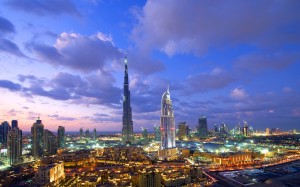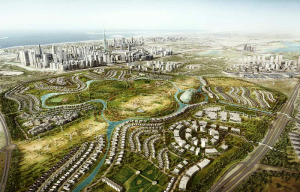Part 1. Economics and Architecture
When seven emirates were united into a country that today is known as United Arab Emirates, Sheikh of Dubai was one of the first that took that opportunity and turned his city into mast visit place. In 90’s Dubai was so economically stable, it made it possible to turn area in the Middle Eastern desert, into a dream city, which by 2014 was visited by half of the world’s population. But this city has experienced ups and downs during its development.
At first the economic performance of Dubai was the main factor that triggered rapid growth of the city. Starting in 1991 city started changing dramatically. The roads started expanding, the bridges started connecting areas that were one separated by river, the building were growing faster than the palm trees. Eight years later more and more people started recognizing Dubai because of its architecture. In 1999 Burj al Arab hotel, built on the first man maid island, became one of the first architectural projects that made Dubai famous. In 2004, thinking that nothing can ever stop them, Dubai starts their biggest project yet, Burj Khalifa (previously known as Burj Dubai), the tallest tower in the world, the tower that can be seen from any point of the city. In 2006 (two years before crisis) Dubai changed to the point that no one could ever imagine. Still thinking that they could go further, Dubai brings more experts in almost every field. They start new projects, and they build a unique city.
No one ever thought that the crisis of 2008 could do much to Dubai. The city never prepared for it. By the end of 2008 more and more constrictions were put on hold or canceled. Apartment occupation dropped, more and more towers became less occupied. By the end of 2009 almost 80% of all towers were empty. Dubai was in debt. The city spent all its resources in order to bring their dream to life. In order to bring Dubai’s economic performance back on track, the government started selling their projects. First the palm island was sold to Abu Dhabi, within the same month Burj Dubai, the tallest tower in the world, was also sold to Abu Dhabi, thus changing the name to Burj Khalifa. Ever since then project were postponed, cancelled or altered in order to have a possibility to be built with current economic situation of the city. The economic performance became a limiting factor for architecture and urbanism, there was no more room for design and unique ideas. Projects had to be functional and cheap.
After living there for 7 years, I’ve experienced the changes that this city went through. It’s known to everyone, the life of a person, city, and even country always has its ups and downs, and Dubai is no exception. In my opinion the unfortunate time came to an end in 2011, when I witnessed an opening of a new tower built by Foster and Partners, the Index tower. A new building that did not substitute design for money. The economic stability started growing, while most of the countries were still suffering from the crisis. The city that was developing for almost twenty years before the crisis, started going back on track. How was this possible? What is one thing that always attracts people? People are always attracted by something new, something undiscovered. Dubai is famous for its modern architecture. For architecture and urbanism that was developing during its best time. In other words, architecture was main reason that started bringing money back to Dubai. Because when we think about architecture, we don’t only think about glass and concrete. Architecture is our everyday life, it’s a flow, and it’s an organism that constantly attracts people.
Part 2. Economics and Sustainability
When we talk about “designing with nature” Dubai is not the first city that comes to anyone’s mind. Since there is no nature to design with. For Dubai it’s more like designing against nature. Being located in a very unwelcoming area, where in summer the temperature reaches 55 degrees Celsius, Dubai’s main goal is to protect people from exposure to the sun or sand storms. In the last couple of years they’ve been rethinking their decisions, and started “creating” nature. Projects that depend on themselves, projects that are dedicated to minimize required inputs of energy, water and food, and waste output of heat, air pollution, and water pollution.
People that build this city today, are depending not only on new technologies and ways of construction, but they also take into consideration local (Middle Eastern) historical architecture. In the past people found ways to live in that harsh environment in comfort. They used local materials in order to build houses. In order to bring cold air into the “shelter” they constructed wind towers that guide air, which cooled down on the way, into the house.
Historical and New ways of building made it possible to create a LEED platinum building. The Change Initiative Building (TCI) in Dubai, UAE, has been awarded 107 out of 110 LEED points from the US green building council, which technically makes it the most sustainable building in the world. The 4,000-square-meter retail shop, which provides sustainable solutions to customers, received the world’s highest LEED Platinum rating. Economic performance of Dubai made it possible to invest into green technologies in order to start a new chapter of construction. More and more projects started following this success. In the near future Dubai will completely turn into an eco-city. Sick building syndrome – a situation where building occupants experience acute health and comfort effects due to unhealthy and toxic material use, will no longer be an issue for Dubai.
But they don’t stop at this point, since there is no actual nature in that region, building green for them doesn’t mean only sustainable ways of building, but literally building green. They don’t design only with materials and new technologies, but also with nature. Urban systems can be more environmentally sustainable than rural or suburban living, with people and resource located so close to one another it is possible to save energy and resources things such as food transportation and mass transit systems. Planting trees and growing food is one of the main challenges that architects deal with nowadays when they design new buildings in Dubai. Today Dubai is building nature, and the economic factor is helping them at achieve this goal.
Right now Dubai is developing a new city called “Mohammed Bin Rashid City” a new “green” frontier for its people. A project that should be self-sufficient without harming habitats and region’s economy, and might also boost its performance.




